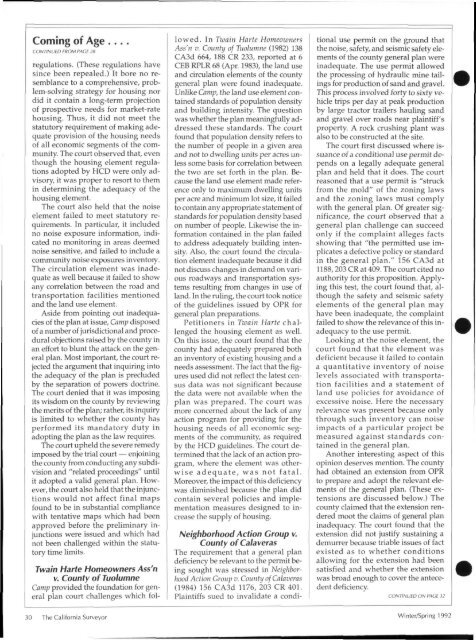Create successful ePaper yourself
Turn your PDF publications into a flip-book with our unique Google optimized e-Paper software.
Coming of Age<br />
CONTINUED FROM PACE 28<br />
regulations. (<strong>The</strong>se regulations have<br />
since been repealed.) It bore no resemblance<br />
to a comprehensive, problem-solving<br />
strategy <strong>for</strong> housing nor<br />
did it contain a long-term projection<br />
of prospective needs <strong>for</strong> market-rate<br />
housing. Thus, it did not meet the<br />
statutory requirement of making adequate<br />
provision of the housing needs<br />
of all economic segments of the community.<br />
<strong>The</strong> court observed that, even<br />
though the housing element regulations<br />
adopted by HCD were only advisory,<br />
it was proper to resort to them<br />
in determining the adequacy of the<br />
housing element.<br />
<strong>The</strong> court also held that the noise<br />
element failed to meet statutory requirements.<br />
In particular, it included<br />
no noise exposure in<strong>for</strong>mation, indicated<br />
no monitoring in areas deemed<br />
noise sensitive, and failed to include a<br />
community noise exposures inventory.<br />
<strong>The</strong> circulation element was inadequate<br />
as well because it failed to show<br />
any correlation between the road and<br />
transportation facilities mentioned<br />
and the land use element.<br />
Aside from pointing out inadequacies<br />
of the plan at issue, Camp disposed<br />
of a number of jurisdictional and procedural<br />
objections raised by the county in<br />
an ef<strong>for</strong>t to blunt the attack on the general<br />
plan. Most important, the court rejected<br />
the argument that inquiring into<br />
the adequacy of the plan is precluded<br />
by the separation of powers doctrine.<br />
<strong>The</strong> court denied that it was imposing<br />
its wisdom on the county by reviewing<br />
the merits of the plan; rather, its inquiry<br />
is limited to whether the county has<br />
per<strong>for</strong>med its mandatory duty in<br />
adopting the plan as the law requires.<br />
<strong>The</strong> court upheld the severe remedy<br />
imposed by the trial court — enjoining<br />
the county from conducting any subdivision<br />
and "related proceedings" until<br />
it adopted a valid general plan. However,<br />
the court also held that the injunctions<br />
would not affect final maps<br />
found to be in substantial compliance<br />
with tentative maps which had been<br />
approved be<strong>for</strong>e the preliminary injunctions<br />
were issued and which had<br />
not been challenged within the statutory<br />
time limits.<br />
Twain Harte Homeowners Ass'n<br />
v. County of Tuolumne<br />
Camp provided the foundation <strong>for</strong> general<br />
plan court challenges which followed.<br />
In Twain Harte Homeowners<br />
Ass'n v. County of Tuolumne (1982) 138<br />
CA3d 664, 188 CR 233, reported at 6<br />
CEB RPLR 68 (Apr. 1983), the land use<br />
and circulation elements of the county<br />
general plan were found inadequate.<br />
Unlike Camp, the land use element contained<br />
standards of population density<br />
and building intensity. <strong>The</strong> question<br />
was whether the plan meaningfully addressed<br />
these standards. <strong>The</strong> court<br />
found that population density refers to<br />
the number of people in a given area<br />
and not to dwelling units per acres unless<br />
some basis <strong>for</strong> correlation between<br />
the two are set <strong>for</strong>th in the plan. Because<br />
the land use element made reference<br />
only to maximum dwelling units<br />
per acre and minimum lot size, it failed<br />
to contain any appropriate statement of<br />
standards <strong>for</strong> population density based<br />
on number of people. Likewise the in<strong>for</strong>mation<br />
contained in the plan failed<br />
to address adequately building intensity.<br />
Also, the court found the circulation<br />
element inadequate because it did<br />
not discuss changes in demand on various<br />
roadways and transportation systems<br />
resulting from changes in use of<br />
land. In the ruling, the court took notice<br />
of the guidelines issued by OPR <strong>for</strong><br />
general plan preparations.<br />
Petitioners in Twain Harte challenged<br />
the housing element as well.<br />
On this issue, the court found that the<br />
county had adequately prepared both<br />
an inventory of existing housing and a<br />
needs assessment. <strong>The</strong> fact that the figures<br />
used did not reflect the latest census<br />
data was not significant because<br />
the data were not available when the<br />
plan was prepared. <strong>The</strong> court was<br />
more concerned about the lack of any<br />
action program <strong>for</strong> providing <strong>for</strong> the<br />
housing needs of all economic segments<br />
of the community, as required<br />
by the HCD guidelines. <strong>The</strong> court determined<br />
that the lack of an action program,<br />
where the element was otherwise<br />
adequate, was not fatal.<br />
Moreover, the impact of this deficiency<br />
was diminished because the plan did<br />
contain several policies and implementation<br />
measures designed to increase<br />
the supply of housing.<br />
Neighborhood Action Group v.<br />
County of Calaveras<br />
<strong>The</strong> requirement that a general plan<br />
deficiency be relevant to the permit being<br />
sought was stressed in Neighborhood<br />
Action Group v. County of Calaveras<br />
(1984) 156 CA3d 1176, 203 CR 401.<br />
Plaintiffs sued to invalidate a conditional<br />
use permit on the ground that<br />
the noise, safety, and seismic safety elements<br />
of the county general plan were<br />
inadequate. <strong>The</strong> use permit allowed<br />
the processing of hydraulic mine tailings<br />
<strong>for</strong> production of sand and gravel.<br />
This process involved <strong>for</strong>ty to sixty vehicle<br />
trips per day at peak production<br />
by large tractor trailers hauling sand<br />
and gravel over roads near plaintiff's<br />
property. A rock crushing plant was<br />
also to be constructed at the site.<br />
<strong>The</strong> court first discussed where issuance<br />
of a conditional use permit depends<br />
on a legally adequate general<br />
plan and held that it does. <strong>The</strong> court<br />
reasoned that a use permit is "struck<br />
from the mold" of the zoning laws<br />
and the zoning laws must comply<br />
with the general plan. Of greater significance,<br />
the court observed that a<br />
general plan challenge can succeed<br />
only if the complaint alleges facts<br />
showing that "the permitted use implicates<br />
a defective policy or standard<br />
in the general plan." 156 CA3d at<br />
1188,203 CR at 409. <strong>The</strong> court cited no<br />
authority <strong>for</strong> this proposition. Applying<br />
this test, the court found that, although<br />
the safety and seismic safety<br />
elements of the general plan may<br />
have been inadequate, the complaint<br />
failed to show the relevance of this inadequacy<br />
to the use permit.<br />
Looking at the noise element, the<br />
court found that the element was<br />
deficient because it failed to contain<br />
a quantitative inventory of noise<br />
levels associated with transportation<br />
facilities and a statement of<br />
land use policies <strong>for</strong> avoidance of<br />
excessive noise. Here the necessary<br />
relevance was present because only<br />
through such inventory can noise<br />
impacts of a particular project be<br />
measured against standards contained<br />
in the general plan.<br />
Another interesting aspect of this<br />
opinion deserves mention. <strong>The</strong> county<br />
had obtained an extension from OPR<br />
to prepare and adopt the relevant elements<br />
of the general plan. (<strong>The</strong>se extensions<br />
are discussed below.) <strong>The</strong><br />
county claimed that the extension rendered<br />
moot the claims of general plan<br />
inadequacy. <strong>The</strong> court found that the<br />
extension did not justify sustaining a<br />
demurrer because triable issues of fact<br />
existed as to whether conditions<br />
allowing <strong>for</strong> the extension had been<br />
satisfied and whether the extension<br />
was broad enough to cover the antecedent<br />
deficiency.<br />
CONTINUED ON PACE 32<br />
30 <strong>The</strong> Cali<strong>for</strong>nia <strong>Surveyor</strong> Winter/Spring 1992
















